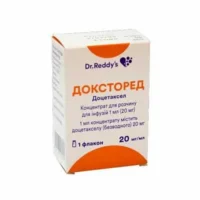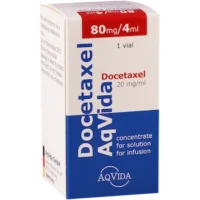Description
Doxorubicin Amaxa (doxorubicin) Solution for Injections 2 mg/ml. 25 ml. Vial №1
Composition
Active Ingredient: Doxorubicin hydrochloride. Inactive ingredients may include hydrochloric acid, sodium chloride, and water for injection.
Mechanism of Action
Doxorubicin, a potent anthracycline chemotherapy agent, exerts its effects by intercalating into DNA strands, inhibiting topoisomerase II, and generating free radicals that induce DNA damage in cancer cells, ultimately leading to cell death.
Pharmacological Properties
Doxorubicin Amaxa possesses strong antitumor activity against various cancers, including breast, lung, and ovarian cancers. It functions by disrupting cancer cell DNA and inhibiting key enzymes involved in cell replication.
Indications for Use
Doxorubicin Amaxa is indicated for the treatment of a wide range of cancers, such as breast cancer, lung cancer, and ovarian cancer. It is commonly used as part of combination chemotherapy regimens.
Contraindications
Avoid using Doxorubicin Amaxa in patients with severe myelosuppression, severe hepatic impairment, or a history of severe hypersensitivity reactions to doxorubicin. Prior assessment of cardiac function is crucial before initiating treatment.
Side Effects
Common side effects of Doxorubicin Amaxa may include nausea, vomiting, hair loss, and myelosuppression. Cardiotoxicity is a significant concern and requires close monitoring during and after treatment.
Usage Instructions
Administer Doxorubicin Amaxa intravenously at a dose ranging from 60 to 75 mg/m² of body surface area every 21 to 28 days. Healthcare professionals should follow recommended administration protocols to ensure optimal treatment outcomes.
Benefits Compared to Analogues
Doxorubicin Amaxa stands out for its well-documented efficacy in combating various cancers and its established safety profile when used according to prescribed guidelines. Its proven track record in clinical settings sets it apart from other chemotherapy agents.
Suitable Patient Groups
Doxorubicin Amaxa is suitable for adult patients with various cancer types. Special caution is necessary when considering its use in pediatric or elderly populations due to potential differences in drug metabolism and tolerance.
Storage and Shelf Life
Store Doxorubicin Amaxa as per the manufacturer’s instructions, typically at controlled room temperature. Check the product label for specific storage conditions. Ensure proper handling to maintain product integrity.
Packaging Description
Doxorubicin Amaxa is available in 25 ml vials for intravenous administration. Each vial contains a sterile solution of doxorubicin hydrochloride and other necessary excipients.
Clinical Evidence and Proven Effectiveness
Doxorubicin has been extensively studied and demonstrated significant efficacy in clinical trials for various cancer types. Its mechanism of action and antitumor properties have been well-documented, making it a cornerstone in cancer treatment protocols.





